I have tremendous respect for Mike Epstein and think that he clearly and significantly advanced the science of hitting instruction.
Among other things, Mike Epstein correctly, and presciently, identified linear hitting as a flawed and illogical approach. As he points outs, why do hitting coaches teach their pupils to hit the ball into the ground when ground balls are what pitching coaches want from their pitchers? Similarly, he understands that the planting of the front heel generally triggers the swing. Also, while other hitting instructors seem to have hundreds of drills that they use and/or recommend, he has just a few key drills that are designed to address the most common problems.
However, while he got many things right, and while my work has been heavily influenced by his approach, I don't think Mike Epstein got everything right.
I discuss my concerns in this and a couple of related pieces...
My Experience with Mike Epstein's Teachings
I first came across Mike Epstein's teachings when working with my older son. I was referred to his work by a number of people and found the things that I learned from Mike Epstein's DVDs to be infinitely better than the Charley Lau Sr.-inspired, Power V at the Point Of Contact nonsense that I had been taught as a kid. As a result, after I incorporated a number of Mike Epstein's teachings, ideas, and drills into my approach to teaching hitting, my older son's swing quickly improved.
However, after making some significant gains, my son ended up hitting a plateau. While he was hitting the ball harder and better than he had before, and did quite well against weak to average pitching, he still had a problem catching up to the better pitchers in the league. When he did manage to make contact off of those harder throwers, the result were generally weakly carved balls to the opposite field.
I had known for a while that my son had had a problem with Bat Drag; that when he swung, his back elbow would slide forward of his hands and his back hip, his front arm would bar out, and the barrel would dump.
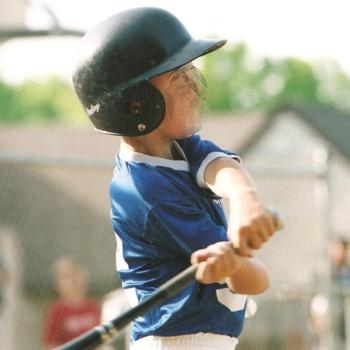
Bat Drag
I hoped that using Mike Epstein's system and drills would help me fix my son's problem with Bat Drag. However, while my son's swing improved and shortened up, when I looked at my son's swing on video, I saw that the Bat Drag was still there.[1]
Another Quest
As happened with my research into pitching mechanics, my son's lingering problems with hitting and Bat Drag led me to research the swing and how it is -- and how it should be -- taught. Eventually, I stumbled across a small community of extremely smart dads -- engineers, physicists, and patent lawyers among them -- who had been in the same position that I was in and who, in an effort to help their own kids, had spent a number of years identifying the strengths and weakness of Mike Epstein's system and teachings.
What they found, and what I learned, was that there are a number of lingering problems with how Mike Epstein teaches hitting; problems that explained why my son's swing improved but why he still had some significant flaws.
The Limits of Mike Epstein's System
The video clip below shows a game swing by a hitter who is doing many of the things that Mike Epstein teaches.[2]
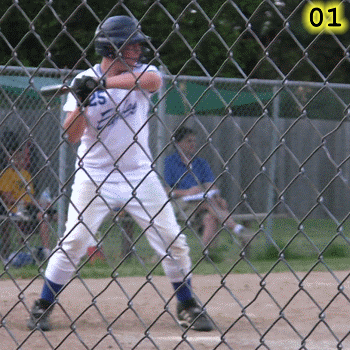
Mike Epstein Inspired Swing
As I learned through my research on the Internet, there are a number of significant problems with this swing.
Bat Drag
First of all, there is serious Bat Drag in this swing.
Notice how the hitter's back elbow slides forward and ahead of his hands around Frame 24, how his front arm bars out in the same frame, and how his back elbow ends up well forward of his back hip at the Point Of Contact (POC) in Frame 30.
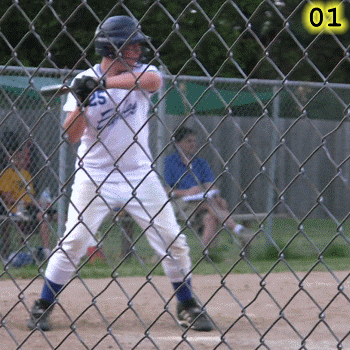
Mike Epstein Inspired Swing
The combination of these problems lengthens his swing by at least three frames, causes him to make contact farther out front than is typical, and forces him to start his swing sooner. That, in turn, makes him vulnerable to off-speed pitches like the one he got in this case.
The issue is that Mike Epstein doesn't seem to recognize Bat Drag or see it as a problem.
In fact, the picture below -- which in truth shows the worst case of Bat Drag I have ever seen -- was used by Mike Epstein in a number of places, including in his piece entitled Choose a Hitting Instructor Wisely, to demonstrate what a good young swing looks like.
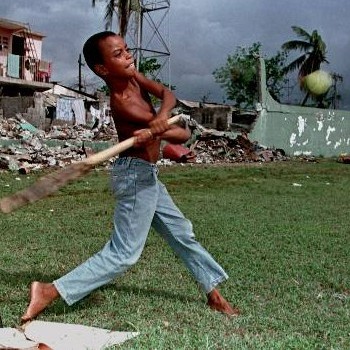
Bat Drag
However, if you compare the picture above to pictures of the best hitters, and in particular focus on the relationship of their back elbows and their back hips, you will see a very different movement pattern.

Albert Pujols at Bat Lag Position
The picture above shows Albert Pujols at the same moment in the swing, with the bat just starting to Whip out into the path of the ball. However, and critically, Albert Pujols' back elbow is in a completely different position. Instead of being well forward of his back hip, Albert Pujols' back elbow is at his back hip. That helps to keep his hands in tight through the Point Of Contact, keeps his swing short, and, as I explain in my piece on Whip and the Back Elbow, increases the force with which the bat head will Whip through the Point Of Contact.
The problem is that, by teaching his hitters to aggressively slot their back elbows, and labeling as good what in truth are flawed swings, Mike Epstein isn't preparing his instructors to deal with the problem of Bat Drag. In fact, and in my experience, by focusing on slotting the back elbow, Mike Epstein may even be predisposing his hitters to Bat Drag.
The Front Elbow Angle
Mike Epstein wants his hitters to set up with their front elbow bent roughly 90 degrees.
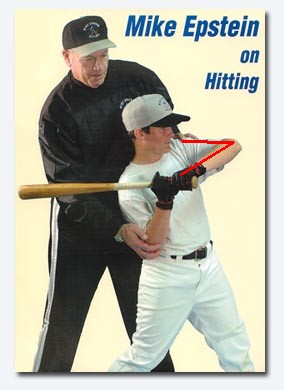
Mike Epstein
Desired Front Elbow Angle
The problem is that no good hitters actually swing with their front elbows bent that much.
Instead, as I learned as a result of shooting clips of hitters from high above -- and as I discuss in greater detail in my piece on The Box, The L, and The Parallelogram -- at the moment they launch their swing, most good hitters' hands are farther back and their front elbows are extended more.
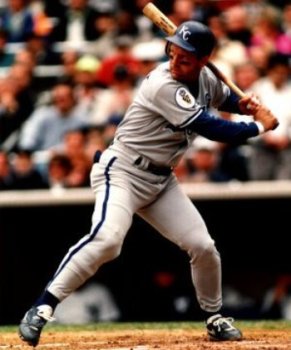
George Brett's Front Elbow Angle
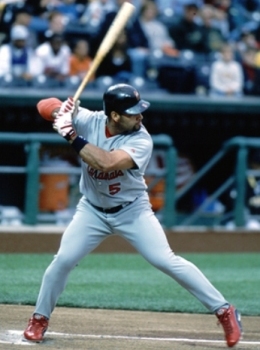
Albert Pujols' Front Elbow Angle
I will be the first to admit that I also used to teach a 90 degree front elbow angle. However, as I accumulated more clips like the ones below, I began to find that it was almost impossible to find hitters whose front elbow were bent 90 degrees. Instead, I found that, in most cases, hitters' front elbows were bent more like 45 degrees.
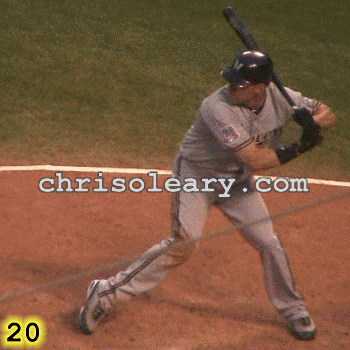
Jim Edmonds' Front Elbow Angle

Albert Pujols' Front Elbow Angle
Part of the problem is that many people assume kids are just short adults when, in truth, they are anything but that. For instance, kids tend to have shoulders that are proportionately much narrower than the shoulders of most adults. As a result, when scaling a drill down from an adult to a child you have to take that difference in shoulder width into account. I do that in my George Brett Drill but I'm not aware of Mike Epstein alerting people to the need to make that tweak to his drills.
I believe that another part of the problem is that people have been told that Bat Wrap is a problem. As a result, I think they are more concerned about the Bat Wrap that the see when kids set up with their bat against the side of their shoulder than they are by the angle of the front elbow. However, I see Bat Wrap in the swings of many good hitters, so much so that I don't believe that Bat Wrap is the problem that people think it is.
Vertical Spine
Mike Epstein doesn't seem to have a correct understanding of the concept of Adjustability; he doesn't seem to understand how good hitters actually adjust to hit balls down in the strike zone. Mike Epstein wants his hitters to set up with a vertical spine and then adjust by hinging their back knee. The problem is that, if you look at clips of what Epstein-trained hitters actually do when swinging at pitches down in the strike zone, you will often see that they have to drop their hands to try to get down to the pitch while still trying to swing level to the ground.[3]

Mike Epstein Inspired Swing
I believe that the root cause of the problem is that Mike Epstein is trying to stay faithful to Ted Williams' book. However, the concept of Adjustability is one of the few things that Ted Williams got wrong in his book.
If you look at the back knee angles of most hitters, while they will vary from hitter to hitter, if you look at several swings from any one hitter, then you will see that their back knee angle stays fairly constant from swing to swing. Instead, the way that hitters adjust to pitches up and down in the strike zone is they Tilt over the plate.
Squishing the Bug
Mike Epstein correctly rails against squishing he bug, but in his Torque Drill he puts his hitters in a Squishing the Bug position.
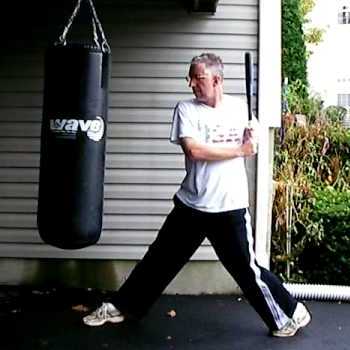
Torque Position
Among other things, the problem with putting a hitter in a Squishing the Bug position is that it will keep the hitter from starting their swing with The Move. It can also limit the hitter's hip rotation.
Vertical Barrel Position
In his book, Mike Epstein teaches that the hitter should set up with their barrel vertical and then launch their swing from that vertical barrel position just like Ted Williams did. The problem is, and as I explain in detail in my piece on Launching the Swing..., Ted Williams didn't actually do that. Trying to launch the swing from a vertical barrel position, and without doing a Running Start, can lead to a number of problems including Dumping the Barrel.
Reverse Weight Shift
Mike Epstein doesn't like the weight shift because it can lead to lunging. He also believes that hitters adjust to the trajectory of the pitch by hinging the back knee. The problem is that if you combine those two things -- a lack of a weight shift and hinging the back knee -- you can very easily end up with a reverse weight shift where the hitter's Center Of Mass moves back toward the catcher rather than forward toward the pitcher. That in turn can rob a hitter of power. That's why, when teaching hitters, I don't stop with the George Brett Drill. After they master the George Brett Drill, I have my hitters move to the Caitlin Benyi Drill or the Paul Molitor Drill, both of which include at least a weight shift if not a small stride.
Extension at the Point Of Contact
I was recently contacted by a AAA ballplayer who told me the following about what he was recently taught by Mike Epstein personally...
Than I went to Epstein again last year he drilled in that I need to get my arms extended in front of me at contact. He had some video to back it up. At the same time I would routinely scan over your website to see if it matched. The end result was a drop off in numbers. I had some power at times but I'd loose the barrel when trying to get extended at contact. The previous year I only focused on exaggerating my rotation and being connected.
The problem, as I explain in greater detail in my piece of the problem of Extension on Every Swing, trying to extend on every swing will rob a hitter of Adjustability.
Notes
[1] The problem wasn't just with my son. I saw the same problems in the swings of other kids his age who were doing the same drills.
[2] This set-up bears a superficial resemblance to the position hitters go from when doing my George Brett Drill. However, there are some important differences. Among other things, when doing the George Brett Drill, hitters should be tilted over the plate, not standing upright. Their front elbow should also be extended more than 90 degrees.
[3] Mike Epstein rarely touches on the critical topic of Adjustability in his books and DVDs. In my opinion, you have to talk about Adjustability because, if you don't, then people will tend to listen to what they hear -- which is more often than not "level swing" -- and will get it wrong. I believe that you have to explicitly teach people to adjust the right way, which includes learning how to Tilt.